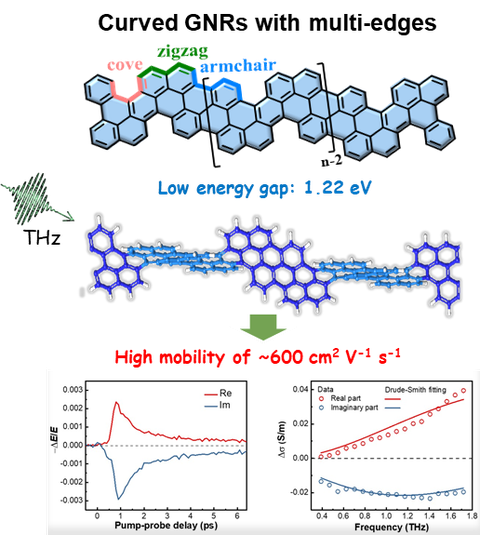Nov 20, 2020
A curved graphene nanoribbon with multi-edge structure and high intrinsic charge carrier mobility
Both theoretical and experimental studies have demonstrated that the electronic and magnetic properties of GNRs are critically dependent on their widths and edge topologies. In contrast to armchair-edged GNRs (AGNRs) displaying semiconducting property with a direct energy gap, zigzag-edged GNRs (ZGNRs) typically exhibit narrow bandgaps and localized edge states. In addition, cove-edged GNRs with unique curved geometry are attractive because they can exhibit improved dispersibility in solution, and provide an additional means to control the optoelectronic properties of GNRs. Thereby, the combination of armchair, cove, and zigzag edge structures can impart GNRs with unique geometries and physiochemical properties that are not accessible by those with solely one type of edge structures.
The scientists from TU Dresden/SJTU/MPIP have demonstrated that the GNR with combined edge structures of cove, zigzag and armchair, synthesized by the team of Prof. Xinliang Feng in TU Dresden, displayed unique curved geometry, corresponding to an excellent liquid-phase dispersibility. This curved GNR exhibited unprecedented absorption in the near infrared region with a maximum peak at ~850 nm and a particular narrow optical energy gap of ~1.22 eV. The group led by Prof. Misha Bonn in MPIP used ultrafast terahertz spectroscopy to investigate the electronic transport properties of the curved GNR. Terahertz studies revealed the high charge scattering time (~60 fs) and record-high intrinsic charge carrier mobility of ~600 cm2 V-1 s-1 for curved GNR. These results hold great promise for multi-edged curved GNRs in many applications, including photothermal conversion, photovoltaics, and nanoelectronic devices, etc. This fruitful work of the joint research has been now published in the renowned journal “Journal of the American Chemical Society”.
This research is a joint collaboration between scientists from the Technische Universität Dresden (TUD), Shanghai Jiao Tong University (SJTU) and the Max Planck Institute for Polymer Research (MPIP). The authors gratefully acknowledge financial support by the National Natural Science Foundation of China (21774076 and 52073173), Program of Shanghai Academic Research Leader (19XD1421700), Deutsche Forschungsgemeinschaft (DFG) for funding (SFB 858), European Union's Horizon 2020 (No 881603 Gra-phene Flagship Core3, No 813036 Marie Skłodowska-Curie), ERC Grant on T2DCP, German DFG (Cluster of Excellence “Center for Advancing Electronics Dresden (cfaed)” and EnhanceNano (No. 391979941), European Social Fund and the Federal State of Saxony (ESFProject “GRAPHD”, TU Dresden), European Commission in the framework of the ERC Grant NOC2D as well as the startup funding from The University of Hong Kong and the funding support from ITC to the SKL.
Reference:
Niu, W.; Ma, J.; Soltani, P.; Zheng, W.; Liu, F.; Popov, A. A.; Weigand, J. J.; Komber, H.; Poliani, E.; Casiraghi, C.; Droste, J.; Hansen, M. R.; Osella, S.; Beljonne, D.; Bonn, M.; Wang, H. I.; Feng, X.; Liu, J.; Mai, Y., A Curved Graphene Nanoribbon with Multi-Edge Structure and High Intrinsic Charge Carrier Mobility. JACS, 2020, 142 (43), 18293-18298.

